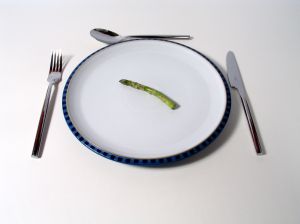The newest diet “science”
 As noted yesterday, there is one diet fad that has misled so many people to believe is credible and scientific, that the Wellcome Trust, a biomedical research charity based in London, has made it the subject of an ethical inquiry. It’s The DNA Diet, which claims you can lose weight and even live longer and healthier by eating based on an analysis of your DNA. In a Guardian article last week, scientists warned consumers about companies marketing these “nutrigenomic” diets on the internet. These companies are charging about $2,000 for a genetic test and personalized diet plan claimed to counter someone’s genetic predisposition to certain cancers, diabetes, heart disease or obesity.
As noted yesterday, there is one diet fad that has misled so many people to believe is credible and scientific, that the Wellcome Trust, a biomedical research charity based in London, has made it the subject of an ethical inquiry. It’s The DNA Diet, which claims you can lose weight and even live longer and healthier by eating based on an analysis of your DNA. In a Guardian article last week, scientists warned consumers about companies marketing these “nutrigenomic” diets on the internet. These companies are charging about $2,000 for a genetic test and personalized diet plan claimed to counter someone’s genetic predisposition to certain cancers, diabetes, heart disease or obesity. There is no science to support these “pie in the sky claims.” They stem from the Human Genome Project, according to Dr. Alison Stewart, chief officer of Cambridge Genetics Knowledge Park. Over the last couple of years, new terms have emerged to describe and legitimize these fields: nutrigenetics and nutrigenomics. Their exact definitions vary, “but most seem to use nutrigenomics to describe the ‘functional’ interactions of food with the genome at the molecular, cellular and systemic levels; while nutrigenetics refers to genetically-determined differences in how individuals react to specific foods,” she said. The problem is, said Stewart, genetics is much more complicated than single genes. Our health is, too. Professors at Wageningen University, Netherlands, outlined the scientific uncertainties and complexities of nutrigenomics, and went on to describe the ethical implications, which they said overshadow potential health benefits. In a comprehensive review of the evidence for Quackwatch, doctors Stephen Barrett and Harriet Hall concluded that companies “offering genetic testing with guidance on diet, supplement strategies, lifestyle changes and/or drug usage they claim can improve health outcomes,” are dubious, have potentially serious harmful implications and should be avoided. According to Helen Wallace, Ph.D., Deputy Director of GeneWatch UK: “For most people, tailoring your diet to your genetic make-up is about as scientific as tailoring your diet to your star sign.” Dr. Serge Jabbour, endocrinologist at Thomas Jefferson University in Philadelphia, told Ivanhoe Broadcast News last month that he thinks DNA diets are just a way to make money and that he “really doubt[s] that at some point in the future, we’re going to discover that a certain gene is going to be responsible for weight gain based on certain foods....or that genetics is going to help with weight loss.” Nutrigenomics takes nutritional science beyond what can be soundly demonstrated in preventing nutritional deficiencies, to unsupportable beliefs in special health-promoting or preventive qualities of certain foods and supplements, or specific evils of others. It plays on the most zealous beliefs in good and bad foods. The human species is also 99.9 percent the same genetically; with the remaining 0.1% of variation accounting for physical differences that are visible and invisible, such as disease-risk. This lends doubt to the efficacy of pharmaceutical and biomedical treatments based on genetics or race/ethnicity. But both the food and medical industries recognize the huge profit potential of nutrigenomics and nutrigenetics. By testing people for their genetics and identifying people that may have markers for vulnerability to certain health problems, they hope to market foods and medicines targeting specific genotypes. This past February, 88 researchers joined in a global initiative to establish nutrigenomics as a new “multidisciplinary science” and set up a genomics databank. The new National Center of Excellence in Nutritional Genomics at UC Davis is leading this initiative, supported in part by the National Institutes of Health. Other nutrigenomic ventures include WellGen, Inc., spun from Rutgers University, New Brunswick, NJ, which notes that the nutrition industry is a $182 Billion industry with a huge potential for growth and profit. In February, it completed a $3 million Series B financing and its website said it raised about $8 million in investor financing in 2004-2006. Jeffrey Bland, president of Metagenics, another nutrigenomic company, spoke last year at the Second Annual World Obesity & Weight Loss Congress about the potential for nutrigenomics. Metagenics already holds multiple patents and “produces over 400 all-natural, research-based products to ‘optimize health.’” But concerns are growing about genetic testing being used to evaluate individuals and how this information might be abused by insurance companies, healthcare organizations, employers and the government to compel compliance with certain lifestyle or medical interventions. The Council for Responsible Genetics based in Cambridge, Massachusetts wrote of hundreds of cases where genetic information has already been misused to discriminate against people with undesirable genetic findings. Commentary: As the diet season begins and the obesity hype is sure to go into high gear, remember that no weight loss method has ever been shown to be effective long-term, and none are benign. The soundest New Year’s resolution of all may be to ignore the weight loss tomfoolery and find something more valuable to do with your time, money and energies.
Click here for complete article (and single page version).

















